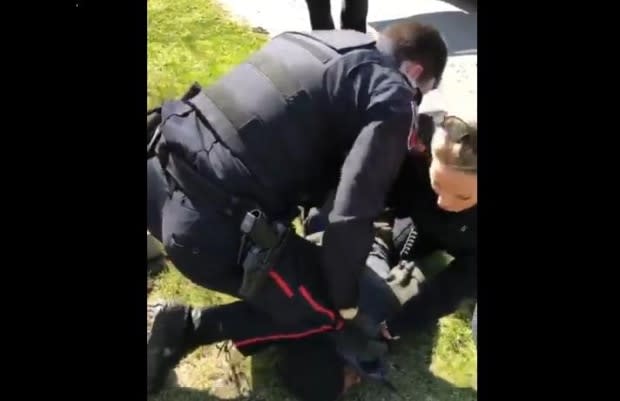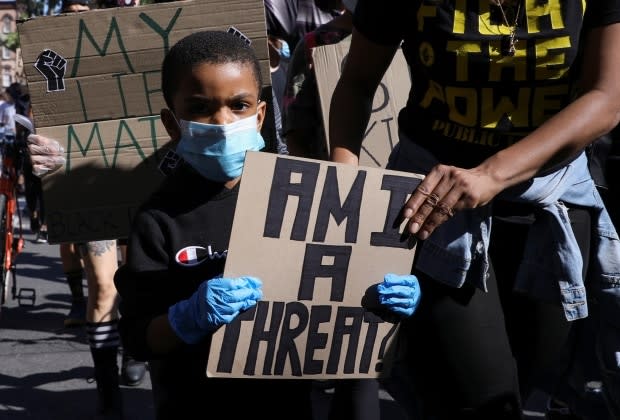As George Floyd's death shines spotlight on knee-on-neck restraint, family of Ontario man speaks out
As the images of George Floyd gasping for air with a police officer kneeling on his neck play over and over again on television screens around the world, the family of Soleiman Faqiri has watched with a gnawing sadness.
It's been three-and-a-half years since the 30-year-old Ontario man, who suffered from schizophrenia, was found lifeless on the floor of a segregation cell at the Central East Correctional Centre in Lindsay, Ont. — after what police have described as an altercation with guards.
A coroner's report initially deemed Faqiri's cause of death "unascertained."
But the case was reopened after an investigation by CBC's The Fifth Estate, in which an inmate across the hall from Faqiri said he watched in horror as guards repeatedly pepper-sprayed and beat him, one of them allegedly pressing his knee into Faqiri's neck.
"George's death struck a particular chord for my family," Faqiri's brother, Yusuf, told CBC News. "When there's no accountability, it seems like these things continue to happen."
Unlike the Floyd case, there is no video of what transpired in Faqiri's cell on the day he died — a fact that has haunted his family.
Faqiri was arrested in Ajax, Ont., on Dec. 4, 2016 after allegedly stabbing his neighbour with an "edged weapon."
The once straight-A student, who was captain of his high school rugby team and attended the University of Waterloo, struggled with schizophrenia and had been apprehended some 10 times under province's Mental Health Act.
This time, though, instead of a hospital, he was taken to a jail cell. Eleven days later, he was dead.
Practice has come under fire before
Exactly what killed Faqiri will be for the coroner to determine; whether a guard kneeled into his neck, for police to investigate.
Police notes from the day of Faqiri's death reference a "blow or pressure" on his neck. And while the coroner's investigation did not zero in on an exact cause of death, it did say the possibility of asphyxiation could not be ruled out.

Ontario Provincial Police are reinvestigating the case, but 18 months on, there is still no update. The Ministry of the Solicitor General has said it cannot comment on the case, pending the police and coroner's investigation, as well as legal proceedings.
The Faqiris have filed a $14.3 million lawsuit over the "excessive force" they believe killed him. The allegations in that lawsuit have not been proved in court.
But in the meantime, Floyd's death is prompting a new focus on the practice of placing a knee on a person's neck to subdue them, with the officer seen kneeling on Floyd's neck now charged with second-degree murder.
The bottom line is that studies have shown time and time again that black males are perceived to be seen as more threatening and dangerous. - Dexter Voisin
The practice has come under fire before in Canada.
A report by Ontario's Office of the Independent Police Review Director (OIPRD) three years ago cites a 2008 coroner's inquest that listed the following recommendation: "Reinforce, through regular and refresher training, the risk of death associated with the use of neck restraining techniques.
"Perhaps the most common issue identified by coroner's juries has been that of police training," the report continued.
"Improved training for police officers focusing on identifying the symptoms of a person in crisis, containment, communication and de-escalation, rather than the use of force has been recommended repeatedly."
No consistent stance on practice in Canada
Toronto Police Chief Mark Saunders came out against the practice at a news conference Thursday.
"I want to be clear that this organization does not, and I repeat, does not train for this. Our members are trained for knee to belt-line techniques. We also train for positional asphyxiation and how to minimize loss of life," Saunders said.
Terry Coleman, a former police chief in Moose Jaw, Sask., told CBC News this week, "If the person's waving their head around, for whatever reason, you put your hand on that, you don't need to kneel on them.
"If they're struggling in such a way that they can be further restrained, you can always put the knee on their shoulder blade or their shoulder."
Still, there is no consistent stance on the practice in this country.
For example, a video from May 2019 recirculating on social media.shows a pair of Durham Regional Police officers restraining a black teen, one placing his knee on the youth's neck.

Durham Police spokesperson George Tudos told CBC News the officers involved did what they felt was "appropriate or necessary to gain compliance" in their confrontation with the 16-year-old, who was reportedly distraught and may have had a knife.
Officers arrived to find the teen with a cut on his hand, and he was taken into custody under Ontario's Mental Health Act.
'Policing isn't perfect, it isn't pretty'
The OIPRD also investigated and found the officers followed proper protocol. No charges were laid.
"Policing isn't perfect, it isn't pretty," Tudos told CBC News. He added the force is always open to reviewing its practices and improving them.
But even in cases where the practice falls within the bounds of police training, the choice of when to use it or not is ultimately up to officers, whose bias can play a role in their decisions, says Dexter Voisin, dean of the Factor-Inwentash Faculty of Social Work at the University of Toronto.
"Even though it might be a sanctioned approach, there's a lot of discretion on the part of police officers in terms of perception of danger," he said.
"The bottom line is that studies have shown time and time again that black males are perceived ... as more threatening and dangerous."

For Yusuf Faqiri and his family, Floyd's case is a painful reminder of that reality.
"Mr. Floyd's death could have been prevented, just like my brother Soleiman's death," Faqiri said.
He cited what he called a systematic problem where the lives of those with mental illness are viewed as "cheap" — especially when they are also people of colour.
"Mental illness does not discriminate on race or ethnicity, but people from vulnerable communities who suffer from mental illness are disproportionately subjected to violent use of force that often lead to death."
Meanwhile, his wait for some measure of justice continues.
"My brother didn't just roll over and die."


